We took a very fun and friendly bunch of people from Holland and Belgium. Big thanks to them for be such a great group. And a extra thanks to Annemieke for writing this trip report. See also forum thread on this trip. See here below for species list. I'm not sure who took which photo, so credit to the whole group for the time being.
Wildlife & Culture trip, Castilla y Leon ; May 2007
- Participants: Geert, Mieneke, Nicole, Jelle, Freek, Peter, Jasper, Maurice en Annemieke
- Guides: Nick, Sergi
- When; 30 April – 6 May, 2007.
5 months after the first contact between Nick and me, we'd set up a trip to the Sierra de la Culebra. My main goal was to see wolves in the wild, others just wanted to experience Spanish wildlife and culture and maybe see some nice birds and reptiles. We've exceeded this ambition and have seen so much more then expected.
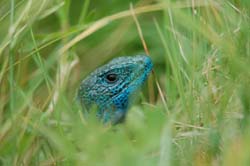 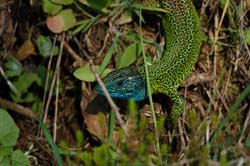
Day 1: Monday 30 April
Journey from the Netherlands to Valladolid airport and further by car to San Pedro de las Herrerias. We were affectionately welcomed by our guides and the hotel owner and after coffee immediately took our first walk. Tracks of wolf, deer, boar were very well visible and fresh! Good promise for our watches.
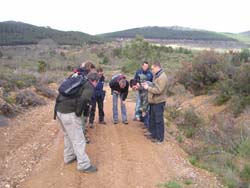 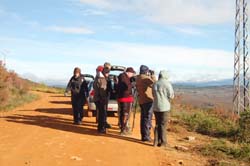
Later that evening we went for our first wolfwatch. Despite the good expectations we only saw large amounts of red and fallow deer but no wolf yet…
Day 2: Tuesday 1 May
The day started with a wolfwatch. Our cars were parked by the side of a sandy road high above a large flattened hilly area. Wolf territory… quiet now. Binoculars, telescopes and every slightly moving brown spot becomes a possible wolf. But then, excitement…Our first view of wolves!! Quite far away but so clear. The pack of three animals stayed in sight for at least 10 minutes before lying down in the tall heather. Everybody was really thrilled to have seen them, this was so great.
Time for a drive in the country. We were taken to Puebla the Sanabria to get some local cheese and wine for lunch. We hiked to one of the last remaining ‘yew forests' in Europe . Halfway we enjoyed bread, olive oil, wine, chorizo and of course the cheese during a great picnic. Weather soon changed for the worst; rain became (soft) snow but we are northern types; prepared for the rain, it didn't stop us. The huge trees were impressive, the atmosphere almost fairytale like.
 
In the small village of Lubian we had a well deserved cup of coffee before taking a steep walk toward the wolf trap, Lubian is famous for. Wolves were caught in a walled corral where they had easily access to, but could not get out. The last wolf captured in this trap was killed somewhere in the early sixties.
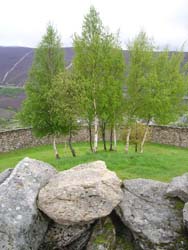 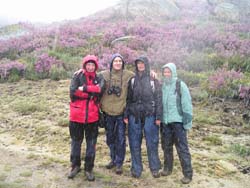
Our evening watched cause even more excitement. More wolves! Interaction with deer made this a very special sight. We considered ourselves very lucky.
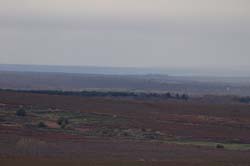 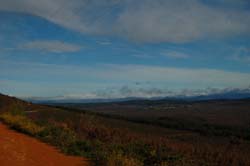
Day 3: Wednesday 2 May
Due to the weather we didn't do a wolfwatch. This gave us the opportunity for a long excursion to the border with Portugal . The mountainous area was simply beautiful, the drive outstanding. Coloured fields; green, red, yellow, purple and forested areas with tall oak trees and a blue sky; what more could we wish for.
In the village of Riomanzanas we talked to some local inhabitants about the man high puppet hanging down from a large stick. Frost, and this puppet will burn, good weather till the end of May and he will be celebrated.

In a village on the border town our trip felt like a journey back in time. A watermill, winepress, blacksmith; this little village takes care of its own basic needs. More and more people abandon this kind of rural communities and only old people stay behind. This type of life vanishes rapid and will become extinct. The neighbouring village is similar.
 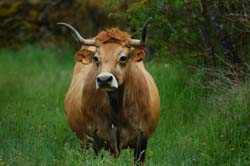
After a drive through the Portuguese landscape we returned to Sierra de la Culebra for lunch.
Sergi arranged a table for 11 people in a tiny old café/bar/shop. Barely enough place for us to sit down, we only knew we were about to eat lamb. The animal was slaughtered the day before and the meat was roasted on a wood fire. Never ever tasted such delicious lamb before!! The bar was owned by this old couple, the kitchen looked like it wasn't cleaned for a decade but the atmosphere was so great. Bottles of wine, dishes with salad, chips and meat were continuously renewed and we're forced to eat till we'd drop down. The meal was completed by ice-cream and after that, real coffee (authentically cooked on the stove). Completely satisfied we thanked the couple for a fantastic experience, but didn't leave the village before we met with the mayor.
Then we went for a look in the renovated town of Santa Cruz de los Cuerragos. Beautiful! Nearby we surrounded the largest chestnut I've ever seen; We needed 5 people to measure the outline. Dark clouds sailing in again, but thunder and lightning, nor rain could stop us from walking uphill for more wolftracks. Unfortunately without result, the rain probably washed all evidence away.
On the way back we walked a little part of the ‘canada real', transhuman paths once used by shepherd's to guide their cattle to the south during winter and north in summer.
The evening wolfwatch was cancelled due to the weather. Instead we spend the evening discussing wildlife as a result from Sergi's ‘Conejo-presentation'.
Day 4: Thursday 3 May
Excellent start of the day; sunny, blue sky; perfect! A family of wild boar passed by. And… again wolves!! Probably they hide because of the weather and now came out. We had to wait a long time though. Watching a herd of red deer suddenly taking of as if scared by something. A close look gave us a brief look of one wolf also running, but the other way. Probably awakened by the red deer …
Again we drove to Portugal , passing beautiful ‘dehesas' were grass and oak trees grow. We paid visit to a shepherd with a flock of sheep first. We were welcomes by the barking of 6 large Leonese Mastiffs and 3 smaller herding dogs. All these dogs to protect his animals from a wolf-attack. We watched the huge spiked collars on these dogs and were explained that indeed his dogs occasionally fought with wolves, so these are no needles accessory.
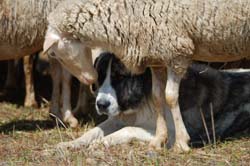
Approaching the ‘Arriba del Douro' nothing of this big gorge was visible. Taking the last curve we got full view this immense canyon and one of it's inhabitants; Egyptian vultures.
Lunch was simple but delicious; tomatoes, cheese, cecina (dried ham) and chorizo accompanied by some wine. Together with the view it gave us a real holiday feeling.
The gorge is famous for their black stork population, although you rarely see them. We saw one individual and it stayed in sight the whole afternoon. Nesting, looking for branches, bathing, flying over; wow! And at the moment we started packing our stuff; an Aguila real, Golden eagle!
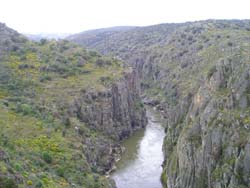 
During the evening wolfwatch we weren't lucky to see wolves, but almost hit a snake while driving home. This 60 cm snake almost had us fooled by pretending to be a viper, but was eventually was identified to be a southern smooth snake. Instead we celebrated Espanyol's victory on Werder Bremen in the quarterfinals of the ‘uefa cup' with bottles of wine, cava and eventually arujo; bad bad combination…what a night, what an atmosphere.
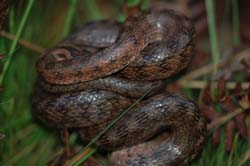 
Day 5: Friday 4 May
No wolves this morning, but after breakfast we started looking for reptiles and amphibians in san Pedro. And we found them; frogs, lizards and salamander tadpoles, so many living within the community. We planned an night walk so we had lunch in the hotel and after this an free afternoon. Time for a short afternoon sleep, a walk in the surroundings of San Pedro or another look at the female ocellated lizard. A short afternoon wolfwatch because we arrived quite late at the spot. No wolves, but nice sighting of red and roe deer.
 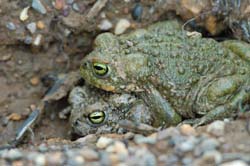
The darkening of the sky was our sign for starting the guided tour through the fields and forest of san Pedro . Antonio, the hotel owner, explained he would never do this alone at night, out of fear for a wolf-attack. No unreasonable fear as we walked right into wolf territory. The amount of people would be save enough. Complete silence. Bird sounds played out loud first only had effect on a disturbed fox and annoying cuckoo, but finally owls. We sat down for diner; a real Catalan sandwich. ‘Frightening' each other with scary stories it got more exciting by the minute. Time to go back. Just passing the graveyard we sat down at the witch tree and after playing the owl sound again we heard a tawny owl calling back. It rapidly approached us and eventually we found it with the light of our torches; nice!
Late that evening we arrived at the hotel and literally crashed into our beds.
Day 5: Saturday 5 May
Time for our last wolfwatch; we changed our watch spot and had a great view on a pair of roe deer very near us. On male with big antlers and a female. No wolves, but we've had our share.
Back in the hotel we packed our belongings, had breakfast and said goodbye to our host Antonio and the beautiful place we stayed these 5 days.
Then we drove eastwards to the famous town of Villafafila . In the meanwhile we saved an terrapin from turning into roadkill and after studying it carefully we returned it safely into the water.
The plains of Villafafila form great habitat for world's biggest flying bird; the great bustard. (“If you see an elephant with wings that's it”) Big birds, if they take off; they look like flying doors!! Pretty impressive. Here we had to say goodbye to our great guides Sergi and Nick who had a long journey ahead of them. The promise of pictures, email, forum and new trips (bears and lynx are very interesting as well) made it no definite goodbye.
We continued to the lakes and saw many more birds feeding in the water, flying through the sky or just sitting down. (a list of all birds can be found in the attachment)
We continued further towards the airport of Valladolid , and found the hotel Nick booked for us. It was situated in a little town in the heart of Montes Torozes close to the large monastery of ‘Santa Espina'. That evening we visited the garden of the convent and during the walk in the village we witnessed a griffon vulture flying by.
Diner we had in the restaurant located right beneath our apartment; El Rincón del Labrador. We choose the chef's speciality; beef. Half a cow hanging in the fridge was sliced to little pieces. We had to bake them our own on a hot stone plate. Such great meat, such friendly people. We finished the meal with glasses Arujo, an real ‘slaapmutsje', nightcap??
Day 6; Sunday 6 may
The next morning we left Spain , tired but with great memories of a good nice trip and very nice people. Thanks to our friends Sergi, Nick, Antonio and Geert for making this possible.
We'll be back! Hasta la vista. Tot ziens, het was heel gezellig!
Species list
Jelle van aalst (see this post http://www.iberianatureforum.com/index.php?topic=322.0 ) has kindly compiled the species list for me.
Mammals
Bat (species unknown)
European Hare (Lepus europaeus)
European Rabbit (Oryctolagus cuniculus)
Iberian Wolf (Canis lupus signatus)
Red Deer (Cervus elaphus)
Red Fox (Vulpes vulpes)
Roe Deer (Capreolus capreolus)
Shrews (2) † (species unknown)
Wild Boar (Sus scrofa)
Amphibians
Bosca's Newt (Triturus boscai)
Common Tree Frog (Hyla arborea)
Fire Salamander (Salamandra salamandra)
Iberian Frog (Rana iberica)
Iberian Water Frog (Rana perezi)
Natterjack (Bufo calamita)
Reptiles
European Pond Terrapin (Emys orbicularis)
Iberian Wall Lizard (Podarcis hispanica)
Large Psammodromus (Psammodromus algirus)
Occellated Lizard (Lacerta lepida)
Schreiber's Green lizard (Lacerta schreiberi)
Slow Worm (Anguis fragilis) †
Southern Smooth Snake (Coronella girondica)
Viperine Snake (Natrix maura)
Western Three-toed Skink (Chalcides striatus) †
|
Birds
Alpine Swift (Apus melba)
Azure-winged Magpie (Cyanopica cyanus)
Barn Swallow (Hirundo rustica)
Black Kite (Milvus migrans)
Black Redstart (Phoenicurus ochruros)
Black Stork (Ciconia nigra)
Blackbird (Turdus merula)
Black-winged Kite (Elanus caeruleus)
Black-winged Stilt (Himantopus himantopus)
Blue Tit (Cyanistes caeruleus)
Carrion Crow (Corvus corone)
Cetti's Warbler (Cettia cetti)
Chaffinch (Fringilla coelebs)
Common Buzzard (Buteo buteo)
Common Crane (Grus grus) (?)
Common Cuckoo (Cuculus canorus)
Common Kestrel (Falco tinnunculus)
Common Kingfisher (Alcedo atthis)
Common Raven (Corvus corax)
Common Swift (Apus apus)
Corn Bunting, Miliaria calandra
Crag Martin (Ptyonoprogne rupestris)
Crested Lark (Galerida cristata)
Crested Tit (Lophophanes cristatus)
Dartford Warbler (Sylvia undata)
Dunnock (Prunella modularis)
Egyptian Vulture (Neophron percnopterus)
Eurasian Jay (Garrulus glandarius)
Eurasian Nuthatch (Sitta europaea)
Eurasian Siskin (Carduelis spinus)
Eurasian Sparrowhawk (Accipiter nisus)
European Bee-eater (Merops apiaster)
European Goldfinch (Carduelis carduelis)
European Magpie (Pica pica)
European Robin (Erithacus rubecula)
European Serin (Serinus serinus)
European Stonechat (Saxicola rubicola)
Golden Eagle (Aquila chrysaetos)
Golden Oriole (Oriolus oriolus)
Great Bustard Otis tarda
Great Grey Shrike (Lanius excubitor)
Great Spotted Cuckoo, Clamator glandarius
Great Spotted Woodpecker (Dendrocopos major)
Great Tit (Parus major)
Green Woodpecker (Picus viridis)
Grey Heron (Ardea cinerea)
Grey Wagtail (Motacilla cinerea)
Griffon Vulture (Gyps fulvus)
Gull-billed Tern (Gelochelidon nilotica)
Hen Harrier (Circus cyaneus)
Hoopoe Upupa epops
House Martin (Delichon urbica)
House Sparrow (Passer domesticus)
Jackdaw (Corvus monedula)
Lesser Kestrel (Falco naumanni)
Linnet (Carduelis cannabina)
Little Egret (Egretta garzetta)
Little Owl (Athene noctua)
Long-tailed Tit (Aegithalos caudatus)
Mallard (aka Wild duck) (Anas platyrhynchos)
Mistle Thrush (Turdus viscivorus)
Montagu's Harrier (Circus pygargus)
Nightingale (Luscinia megarhynchos)
Northern Lapwing (Vanellus vanellus)
Northern Shoveler (Anas clypeata)
Northern Wheatear (Oenanthe oenanthe)
Peregrine Falcon (Falco peregrinus)
Pied Avocet (Recurvirostra avosetta)
Red Kite (Milvus milvus)
Red-legged Partridge (Alectoris rufa)
Red-rumped Swallow (Cecropis daurica)
Rock bunting (Emberiza cia)
Short-eared Owl (Asio flammeus)
Skylark (Alauda arvensis)
Spotless Starling (Sturnus unicolor)
Tawny Owl (Strix aluco)
Tree Sparrow (Passer montanus)
Whimbrel Numenius phaeopus
White Stork (Ciconia ciconia)
White Wagtail (Motacilla alba)
Winter Wren (Troglodytes troglodytes)
Wood Pigeon (Columba palumbus)
Woodchat Shrike (Lanius senator)
Woodlark (Lullula arborea) |
|